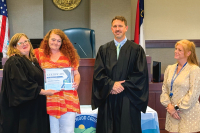The Second Act: ‘Unto These Hills’ opens with a new look that aims to draw big crowds and give a more authentic account of Cherokee history and culture
By Michael Beadle
It’s a story 10,000 years in the making. And now Cherokees and Native Americans from all over the United States will tell it.
When “Unto These Hills” opens June 8 for its latest outdoor season, audiences will find a whole new show — a new script, new cast, new stage, new Surround Sound speakers, new costumes and outfits, new songs and dances, and a new kind of energy that the drama’s management says has been missing for years.
Backed by multi-million-dollar grants from the Cherokee Preservation Foundation, “Unto These Hills” got a huge revamping during the off-season after ticket sales had steadily fallen in recent years and critics complained that the long-running outdoor drama, begun in 1950, was outdated and didn’t involve many local Cherokees in the production.
One of the first steps was to hire a new director, Hanay Geiogamah, to write a new and improved script. Geiogamah, a Kiowa Indian, is a UCLA theatre professor and founding member of the American Indian Dance Theatre. “Unto These Hills” also brought in an all-Native American crew that includes a Pawnee production head, an Ojibwe co-writer, a Seneca composer, a Wampanoag choreographer, and a cast of mostly Cherokee actors who have transformed the show into a majority-Native American production for the first time in more than half a century. Cherokees may not have the major leadership roles yet, but Geiogamah’s goal is to help build more drama, music and dance programs in Cherokee to nurture the next generation of cast and crew for “Unto These Hills.”
About 130 people showed up for the local auditions in early May. Of the 54 people in the cast, 37 are Cherokee. Forty-five Cherokees in all are in the show.
Related Items
“And we didn’t think that was going to happen the first couple of years,” said James Bradley, executive director of “Unto These Hills” and a former Eagle Dancer in the show.
Cherokee actors who were formerly anonymous members of crowd scenes have turned out to be major actors in this year’s production.
“Everybody was really excited about all the changes,” Bradley said. “The rehearsals are more collaborative than they’ve ever been.”
Along with the excitement, there’s a bit of anxiety too. Just a few weeks before opening night, Bradley toured backstage as costume designers were sewing new outfits and new lighting fixtures had just been unpacked from bubble-wrapped boxes. A construction crew was working to complete new additions on the stage including a rotating council house and a stairway entrance. Dressing rooms have been cleaned up and set with rows of mirrors.
Ruth Mitchell, wigs and make-up designer for the show, is working in what was formerly a dressing room. She and assistants piece together hair for about 20 wigs. Down the hall, Dmitri Seth, a costume designer from Los Angeles, shows off a series of clan spirit costumes designed by Robert Jones and his New York City crew (who also designed costumes for Broadway productions of “The Phantom of the Opera” and “The Lion King”).
Seth, a Nez Perce Indian originally from Idaho, makes a distinction between “costumes” and “outfits.” The clan spirit designs are “costumes,” based on supernatural beings from Cherokee mythology while Seth’s designs of shirts and pants are “outfits” worn for social gatherings and re-enactment scenes. Costumes are the kinds of showy clothing worn by clowns or at Halloween while outfits are realistic dress. Being an integral part of the new look of “Unto These Hills,” Seth maintains a keen eye on its authenticity.
“It makes me work harder,” he said.
For Seth’s first experience with an outdoor drama, he enjoyed doing a lot of research to find out what was worn in a certain time period. The show encompasses thousands of years, and only so many costumes can be used. Some of the older costumes from previous shows are being refurbished. Thanks to a collaboration with Western Carolina University’s theatre department, teams of designers are working with students and faculty at Western’s Cullowhee campus and on site at Unto These Hills.
Designers had to factor in the humidity, warm temperatures and summer rain when designing outfits. Actors work up a sweat dancing, and the moist air can build up mold and mildew, so fabrics need to be made of cottons and natural fibers that are washable and last through the wear-and-tear of summer shows and beyond.
If the show sounds better this year, it’s because of the 15-plus new Surround Sound speakers placed along the sides and back of the Mountainside Theatre. An enclosed booth in the center rear of the theatre will monitor sound changes as needed during the show. New lighting fixtures are also being installed.
“Every seat should have a really good sense of the action,” said John Tissue, theatre manager for Unto These Hills.
As of June 5, the show had sold about $87,000 worth of tickets in it’s first-ever preseason run.
While the buzz of energy has been fun to watch, Bradley says it’s a bit strange this year walking up the hill to the actors’ housing. After decades of seeing some of the same faces every summer at the theatre, now he says, “There’s all these new people I don’t know. That whole culture has changed.”









